Getting to yes: Using negotiation in the therapeutic process.
Walt Fritz, PT
(Updated January 2024)
In this article, I want to dive deeply into the options available to the therapist, explicitly using a patient-centered, negotiation-driven model of care. A model like this becomes a therapeutic partnership, an alliance for a common goal. Contrast this model with the more common therapist-centered model, where the clinician is seen as the expert, capable of independently making decisions about diagnosis and treatment. While therapists immersed in their expertise may take umbrage to my characterizations, I ask for patience to allow this explanation to play out.
Though I was trained in the clinician-as-expert model of manual care, over the past two decades, I’ve transitioned my physical therapy practice and continuing education classes into one featuring shared decision-making (SDM), allowing negotiation throughout the treatment process. With negotiation, the application of intervention becomes balanced. Without negotiation, intervention is driven solely by the therapist’s beliefs and experience (ego), possibly missing out on an outcome that has better meaning to the patient.
“Getting to Yes,” by Roger Fisher, was a best-selling business book published in 1991. The Amazon.com summary states, “It is based on the work of the Harvard Negotiation Project, a group that deals with all levels of negotiation and conflict resolution. Getting to Yes offers a proven, step-by-step strategy for reaching mutually acceptable agreements in every sort of conflict.” I remember hearing of it earlier in my career, and the memory surfaced recently as a potential frame of reference regarding the manual therapy I currently use and teach. While the phrase, getting to yes, might be somewhat narrowly focused regarding the outcome of manual therapy, I see it as a productive and necessary step to fulfill before determining treatment. The concepts presented in “Getting to Yes” have meaning today.
Like most other intervention methods, manual therapy (MT) training has a predictable pattern, many of which I’ve witnessed since beginning my formalized MT training in 1992. Whether it be the commonly seen problems of pain or movement disorders faced by physical therapists and massage therapists or the need to reduce the severity of the impact of dysphagia, dysphonia, trismus, and the full range of other diagnoses facing the speech-language pathologist, orofacial clinicians, and others, the application, brand, or style appears to matter little. The timeline often proceeds as follows: when first exposed to a new type of intervention strategy, typically through continuing education, the clinician conservatively doses the therapy, not quite sure of its value or their level of skill. With experience, the therapist uses the modality with greater comfort. With apparent positive results, additional training will often be pursued or encouraged. An illusion is usually formed, where the clinician believes that as their expertise and knowledge improve, their ability to determine the cause of a problem and the correct technique is also enhanced. With that confidence often comes the belief that they can better determine what is wrong with the patient and know how to remediate the issue. Such confidence allows the clinician to feel prepared to help another person through a process that the person knows little about. However, might acting with such certainty minimize the patient’s perspective, values, and preferences, perspectives that can both help and hinder a process?
No matter our profession, we are seen as experts in our respective fields, well-prepared to understand the deeper issues underlying a disorder and know which intervention to apply to remedy that problem. This reasoning seems standard practice in most healthcare and typically meets with success. However, are there ways to improve outcomes? Are there ways to enhance patient buy-in? Are there ways to better honor the three aspects of the evidence-based practice model (EBP)?
I ask readers to keep in mind the three equal elements of EBP:
- The published evidence,
- Clinician’s experience applying the evidence, and
- Patient perspectives and preferences concerning the evidence and the clinician’s perspectives.
Those three legs are taught in most health-related curriculums and were established to improve the quality of interventions. However, of those three inclusions, I believe that patient perspectives and preferences are given far too little emphasis and respect across the broad spectrum of healthcare. Recent trends in narrative medicine and other more patient-centric approaches are beginning to create change, but manual therapy models seem to have lagged behind others. I propose a method and model that contrasts sharply with traditional MT clinician-as-expert training approaches (where the therapist is seen as capable of making treatment decisions on the patient’s behalf). I propose elevating patient perspectives and preferences to carry equal weight with the evidence and the clinician’s experience applying said evidence. Some call this approach a shared decision-making (SDM) model, a moniker I use throughout my writing and coursework.
I’ve been exposed to many learning models in my years of learning and applying MT. Being encouraged to pursue additional coursework was a given, actively encouraged, and sometimes required. Early on (myofascial release and craniosacral training), working intuitively was highly stressed, though ill-defined. I was invited to develop my intuition to work toward having a deeper understanding of processes that, in essence, allowed me to see inside another person. I was taught to determine what was wrong with my patients through various means by merely looking at them. These skills involved conventional evaluation methods, such as postural assessment and movement observance. I noted postural deviations from an idealized norm and observed movements that deviated from similar idealized perspectives. I was taught how to interpret those findings based on the model being introduced. Postural deviations were seen as problematic due to explanations steeped in physicals and biomechanics: if the machine is not well-aligned, it is bound to fail. We were taught to align the body for optimal performance. These are not uncommon perspectives and continue to be presented in current educational models. But the human body and condition are not machines. It is complex and unique, capable of adapting to stressors and conditions that appear to belie traditional mechanistic models of explanation.
I was also encouraged to “read” the body, seeing patterns, colors, and holding patterns that would lead me to know what treatment needed to be done. Suppose all of this sounds far-fetched; welcome to the world of pseudoscience. To many, these concepts make sense but are often mere logical fallacies. Using the taught approach seemed to result in positive outcomes, and armed with such power, why would I have stopped believing in the basic tenets of that myofascial release approach I had learned?
The clinician determines if their preferred treatment style might be helpful in the typical MT intervention. That exercise alone is biased, especially if, in the eyes of the therapist, manual therapy is one of their go-to tools. I recognize this bias as my own, though I try to see through it. Myofascial release had been my bias, tool, and belief for at least twenty years. People come to me daily in pain or living with dysfunction, and I apply my biases toward their issues. Over the years of using MFR, I saw the trend I sank into, objectifying their condition as a simple set of fascial restrictions set in place from injury, trauma, surgery, or other conditions, conditions that my skillset was especially good at remediating. Every patient became the nail, well-suited for my hammer. My biases were reinforced by success with many of the patients who sought me out. If the theories behind my fascial training were correct, then my interventions should be helpful, which they were. No dilemma existed, even though many outside my MFR tribe saw significant problems with the explanatory narrative utilized in MFR and many other modalities targeting tissues and pathologies.
This dilemma seems nebulous and meaningless to the uninitiated, those new to manual therapy. But the dilemma is real to those who’ve spent time exploring the various modality rabbit holes. How can so many modalities have the answer? Can each tissue/pathology-based manual therapy model truly singularly and selectively access and successfully intervene in that dysfunction? Can there be so many unique tissue-based problems in the body that lie in wait for the therapist specially trained in a model devoted solely to that problem? Is it a “myofascial restriction” that is remediated by an MFR therapist? Is the trigger point therapist remediating that trigger point, or are they applying a work that patients benefit from, no matter the mechanism of action? Is the gentle, affective touch used by the craniosacral therapist really balancing the body’s craniosacral rhythm and movement of spinal fluid, or is their light touch impacting autonomic centers, capable of introducing the same changes the CST clinician believes are due to other pathologies? These questions are often seen as heretical by devotees of tissue and pathology-based manual therapy modality families as they question the fundamental underpinnings taught. Such talk is often squelched. However, these are conversations that need to occur.
Manual therapy is often helpful for many disorders, whether in the niche of voice and swallowing or the larger body of conditions impacting human existence. But does MT work in the manner described by its followers? Diving deeply into the evidence pulls out a relative lack of irrefutable proof of both the tissue-based dysfunctions that are responsible for the disorders we treat and our ability to impact those tissues for intervention selectively. Such omissions are lacking in nearly all the published scientific literature that studies the efficacy of manual therapy, though many readers of the evidence fail to see the problem. In most manual therapy papers, there is a conflation of the mechanism of action and efficacy (or positive outcomes). Proving efficacy is often allowed to be sufficient proof of the stated mechanism of action. The complexity of the human condition is seldom reducible to problems in one tissue or region, be it muscle, fascia, tongue ties, postural deviation, flexibility, or strength, especially when viewed through the lens of biopsychosocial understanding.
Despite enormous progress in scientific understanding of pathologies and models of care, we are still not at a place of complete understanding. Instead of choosing a tissue or pathology-based model of manual therapy, I’ve modified my process to allow the patient to be the focus of care. This shift represents a movement towards patient empowerment rather than my skill and beliefs being the centerpiece. While I fully admit I cannot abandon my knowledge, training, and past experiences (ego/bias) entirely, I attempt to temper such factors by fostering a relationship where my patient plays a more active role in determining treatment. In my classes, I speak to this as a point of distinction between other modalities and perspectives. In many trainings, whether it is a model teaching manual circumlaryngeal treatment (MCT) or more broadly applied myofascial release and manual therapy, the clinician is tasked with locating the problem, often based on palpation. The clinician’s training strongly biases this palpation. While one therapist trained in MCT, for instance, may feel excessive muscle tension, another clinician trained in myofascial release may feel fascial restrictions. It is quite possible that what they think through this palpation is the same “thing.” Such conflicts are seldom spoken of across MT circles, as each prefers to stay within their tribal narratives.
In my view, the historical “clinician-as-expert” model lacks one major component; no matter how much I know how much training I’ve had, I cannot determine what a patient is feeling. I cannot palpate what a patient feels might be helpful or harmful. I cannot palpate or evaluate a patient’s expectations, preferences, and perspectives. Working in a one-way fashion, where the clinician is tasked with determining what is best for another human being, allows only one person’s voice to be heard.
So, how can one overcome these obstacles? How does using a patient-centered model that instills ownership of the patient’s perspective and preferences matter within the uncertainty mentioned above? I believe that it matters because of the uncertainty. We cannot be sure if our tissue-based beliefs are accurate, which is a troubling concept. Sure, many outcome-based studies point to positive outcomes when a model of care is applied. But none of those studies dives deeply into understanding the complete mechanisms of action that touch and MT play. Lacking a comprehensive mechanism of action for the results of our work requires us to exist in an uncertain world. However, there is hope.
Those who inform my views are researchers such as Bialosky (2028), Geri (2020), Kolb (2020), Roy (2019), and Weppler (2010), who, through various perspectives, point to higher levels of influence and control in terms of why changes might be elicited at the periphery. They are not negating the possibility of what we’ve learned about local effect manual therapy models but instead point to other influences and factors that drive change. The tapestry we work with (and from) is a rich one.
I continue to use palpation in my intervention and teach it during each of my seminars. But instead of palpating to locate the cause or actual location of a condition, like most other manual therapy models, I use palpation to begin a communication process with my patient. In older models, palpation leads to the conclusion, “I’ve found your (muscle tension, fascial restriction, trigger point, etc.); let’s see what we can do about this.” Treatment typically follows the findings of palpation. I propose a model that uses that same palpation. However, palpation is used to begin a conversation with my patient. “This area seems tight; does this feel familiar to you?” From this point, SDM starts.
In MFR, my evaluation findings led me to know what needed to be done. I was a fascial expert, a trait few of my patients shared (or even understood). My treatment suggestions may have seemed foreign to most patients, but my reputation and the hope that I would help allowed them to trust me. I cannot discard all my experience, but the more I learn, the more I mistrust my instincts. I’ve learned to trust my patients more and work to temper my beliefs with the knowledge that I do not know what my patients are feeling, what they hope for, and what they might fear unless I ask. I have no way of truly knowing if they will ask me to move into their pain or dysfunctional feelings or lighten up my touch and pressure into a feeling they identify as helpful unless I ask. I have no way of knowing what sort of pressure/pain tolerance they might have unless I ask. I have no way of knowing if the things I’ve located through palpation or other evaluation could be significant, beneficial, or harmful unless I ask. Despite all my training and experience, I can never know the answers to these and countless other questions unless I ask. But most manual therapy training is built on a process that doesn’t ask; the patient’s input is often minimized or at least deferred to the therapist’s clinical expertise. Usually, this all works well in the end, but are there ways to improve this process?
Coupling our expertise and training with the expectations and perspectives of the patient is the crux of my approach. It is what gets us to yes. “Yes, that feels helpful,” or “Yes, I think this might be useful.” Getting to yes brings the therapeutic process into a partnership, an alliance. Of course, we can’t just ask our patients what they think is wrong with them, ask them what we should do, and then do it…or can’t we?
I recently listened to a podcast from a few well-regarding physical therapists who were speaking about shared decision-making and patient-centered care. With a note of sarcasm, when talking about patients not knowing the nitty-gritty of physical therapy, one quipped, “Well, it’s not like we can ask our patients to choose what exercises they wish to do.” This remark provided a laugh to the other expert PT. In their world, expertise drives interventions, despite many studies published over the past ten years showing that the specificity of exercise interventions matters less than once thought. Exercise is helpful, but few physical therapists know why (Powell, 2022). Rather than choosing the correct intervention, some authors have linked the alliance built between patient and provider as one of the more significant influencers of change (Alodaibi 2021). Manual therapy studies have shown similar issues. For instance, the specificity of MT for laryngeal dysfunction was seen to be unnecessary when compared to more global MT treatment Ternström et al. (2000). Manual therapy intervention is complex, so far as mechanisms at play and quickly move into behavioral aspects of the therapeutic relationship, patient expectations and fears, and many more concepts that remain in the shadows. Our educational and continuing education poorly prepared us for these uncertainties.
The way I teach my work is to use palpation as a place to begin a meaningful conversation about what brought them (the patient) into my clinic. As soon as I feel something that, from my past, feels interesting, I see if I am getting my patient’s attention. I immediately try to ascertain if they are feeling something familiar, something they’ve felt before, or associated with the condition or issues that brought them to see me. I put them to work in ways many have never experienced. In essence, I force them to help me help them. I work toward finding a tactile cue that connects with a feeling they’ve felt before, good or bad, and is somehow relevant to them. I do very little selling of an approach or beliefs. If what I’m palpating does not replicate one of these conditions, I move on. If it does connect with their experience, I ask them if the stretch that I am performing feels like it might be helpful. If so, I ask them if they want me to hold the stretch for a while to see if we can change the outcome. If there is anything about my palpation-found stretch that feels like it may not be helpful, I will ask them if it feels like it might be harmful. If so, I immediately stop without any form of coercion. I am attempting to get to yes with them, to find a pressure, stretch, or engagement that they feel will be useful and helpful. I let them decide what constitutes a yes, not me. I allow them to decide what level of pressure or engagement is too much or ineffectual. Many will defer to me; “do what you think is best; I can take it.” With such responses, I will work to allow them to see their place in this therapy. If a more painful treatment I desired, it should come from them and not from me. I let them know that while many believe it must hurt to help, others feel quite differently and that the research doesn’t support that view. But if their lived experience wishes deeper, more painful intervention, I will work with them to meet their needs and desires. If they prefer lighter pressures, I need to assure them they are not sabotaging their process. I require them to participate fully in the therapeutic process and put them in a position of responsibility for helping me help them. Getting to yes, to me, forms a crucial tipping point in the process that moves us from evaluation to treatment.
Have you ever heard of a patient/client leaving a massage session, for instance, saying something like, “That therapist was so good that they were able to find things I didn’t even know that I had!” I have, and I detest, such statements only because the therapist possibly did a somewhat unethical job of selling pathologies to a vulnerable public. Nothing I find is meaningful unless confirmed by my patient. All of this is hard work, though I consider it good work.
Getting to yes. That is my mandate.
Walt Fritz, PT
Foundations in Manual Therapy Seminars
www.WaltFritz.com
Alodaibi, F., Beneciuk, J., Holmes, R., Kareha, S., Hayes, D., & Fritz, J. (2021). The Relationship of the Therapeutic Alliance to Patient Characteristics and Functional Outcome During an Episode of Physical Therapy Care for Patients With Low Back Pain: An Observational Study. Physical therapy, 101(4), pzab026. https://doi.org/10.1093/ptj/pzab026
Bialosky, J. E., Beneciuk, J. M., Bishop, M. D., Coronado, R. A., Penza, C. W., Simon, C. B., & George, S. Z. (2018). Unraveling the Mechanisms of Manual Therapy: Modeling an Approach. The Journal of orthopaedic and sports physical therapy, 48(1), 8–18. https://doi.org/10.2519/jospt.2018.7476
Geri, T., Viceconti, A., Minacci, M., Testa, M., & Rossettini, G. (2019). Manual therapy: Exploiting the role of human touch. Musculoskeletal science & practice, 44, 102044. https://doi.org/10.1016/j.msksp.2019.07.008
Kolb, W. H., McDevitt, A. W., Young, J., & Shamus, E. (2020). The evolution of manual therapy education: what are we waiting for?. The Journal of manual & manipulative therapy, 28(1), 1–3. https://doi.org/10.1080/10669817.2020.1703315
Powell, J. K., Schram, B., Lewis, J., & Hing, W. (2023). Physiotherapists nearly always prescribe exercise for rotator cuff-related shoulder pain; but why? A cross-sectional international survey of physiotherapists. Musculoskeletal care, 21(1), 253–263. https://doi.org/10.1002/msc.1699
Roy, N., Dietrich, M., Blomgren, M., Heller, A., Houtz, D. R., & Lee, J. (2019). Exploring the Neural Bases of Primary Muscle Tension Dysphonia: A Case Study Using Functional Magnetic Resonance Imaging. Journal of voice: official journal of the Voice Foundation, 33(2), 183–194. https://doi.org/10.1016/j.jvoice.2017.11.009
Ternström, S., Andersson, M., & Bergman, U. (2000). An effect of body massage on voice loudness and phonation frequency in reading. Logopedics, phoniatrics, vocology, 25(4), 146–150. https://doi.org/10.1080/140154300750067520
Weppler, C. H., & Magnusson, S. P. (2010). Increasing muscle extensibility: a matter of increasing length or modifying sensation?. Physical therapy, 90(3), 438–449. https://doi.org/10.2522/ptj.20090012

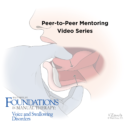
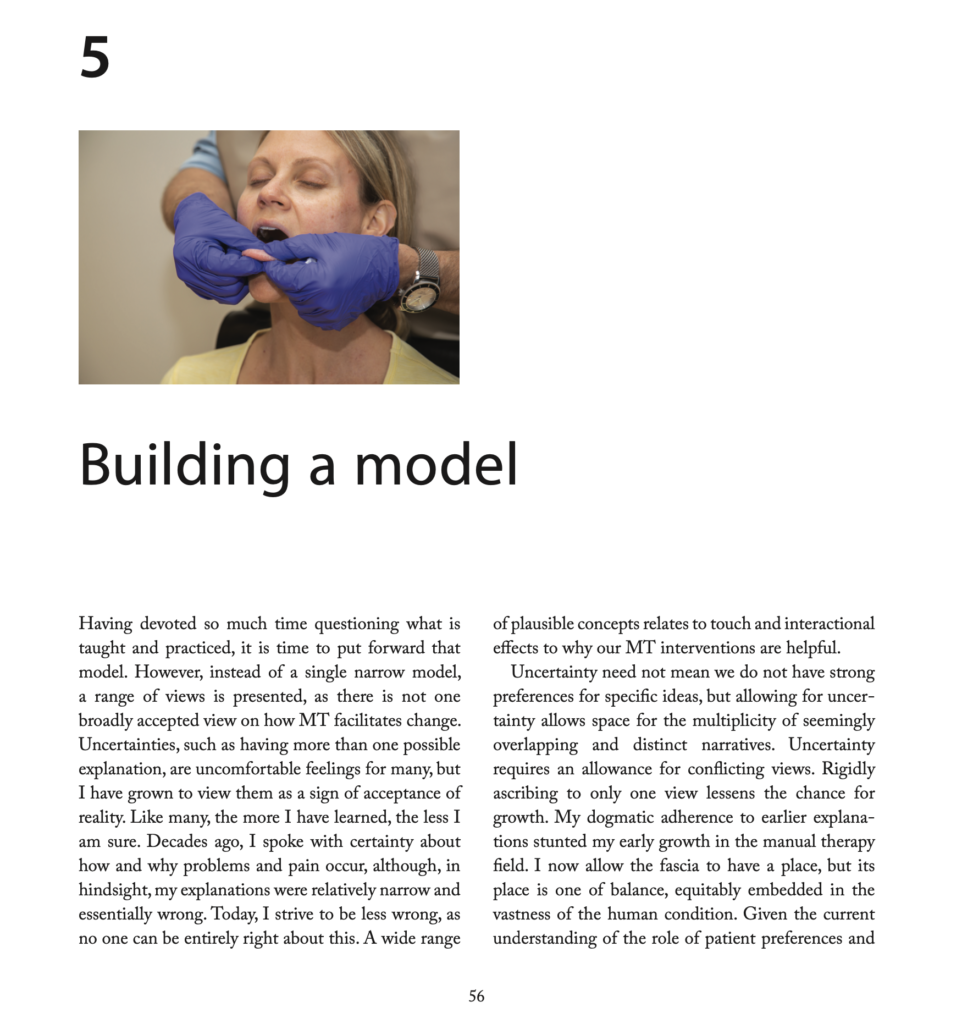

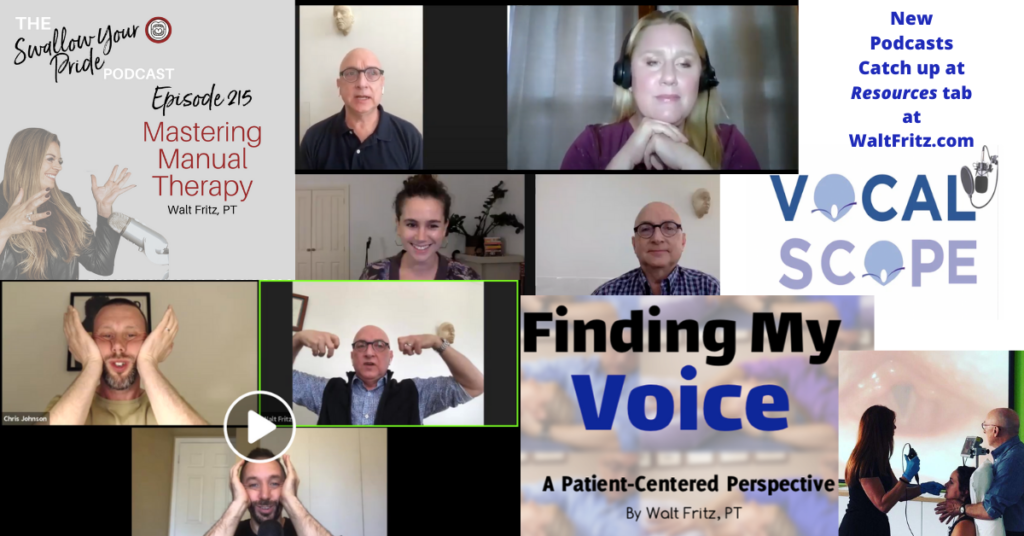
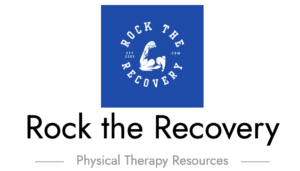
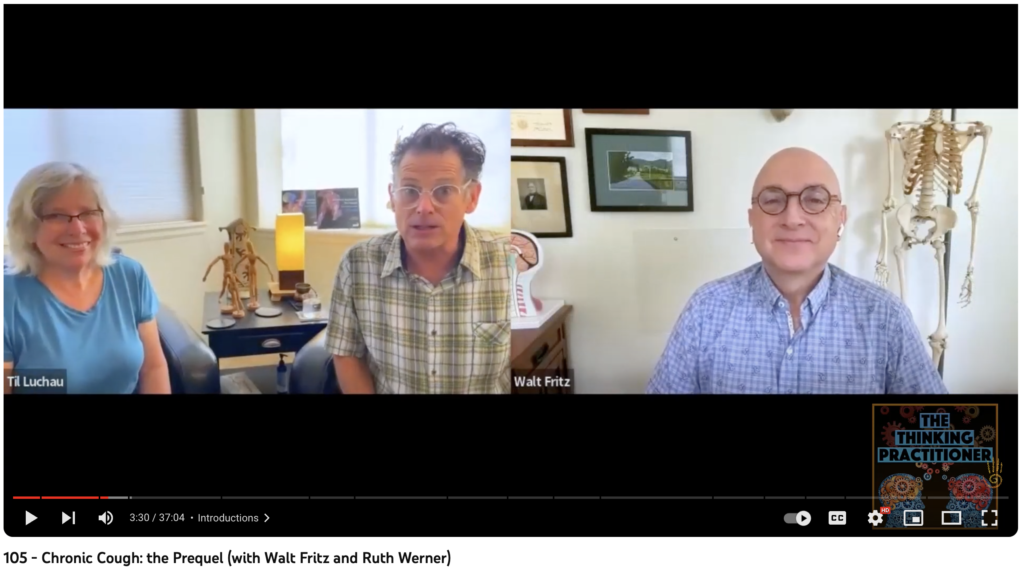
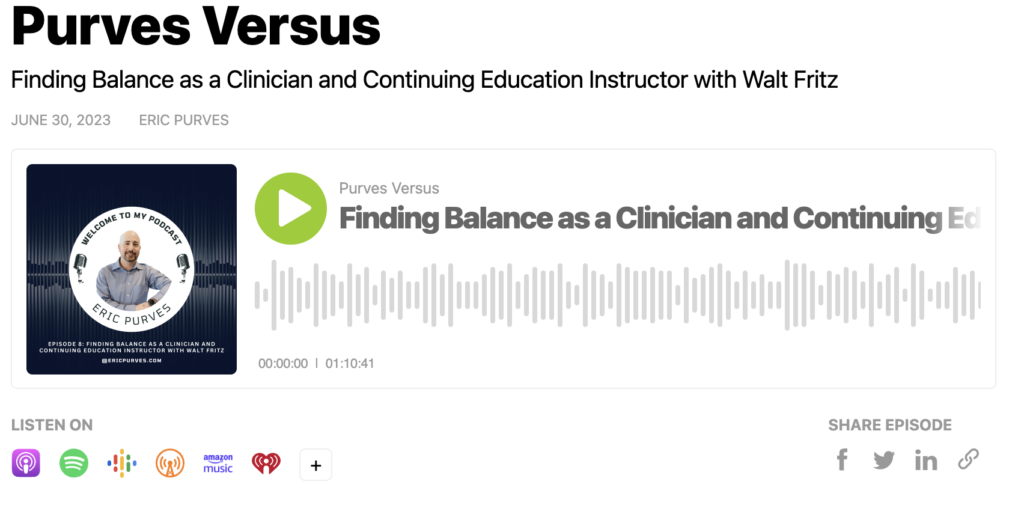
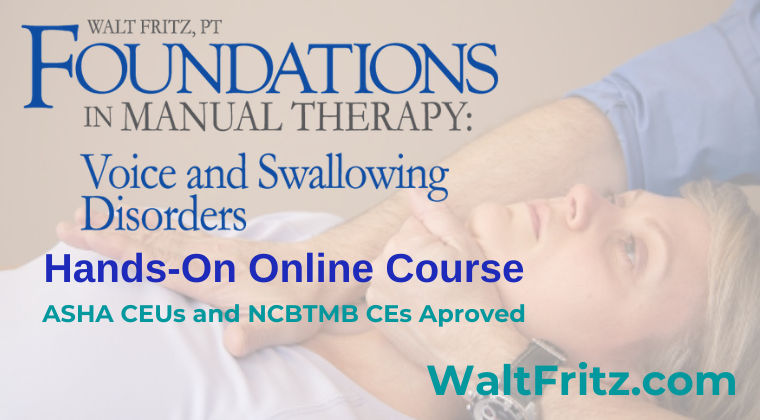

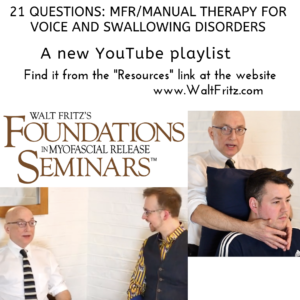









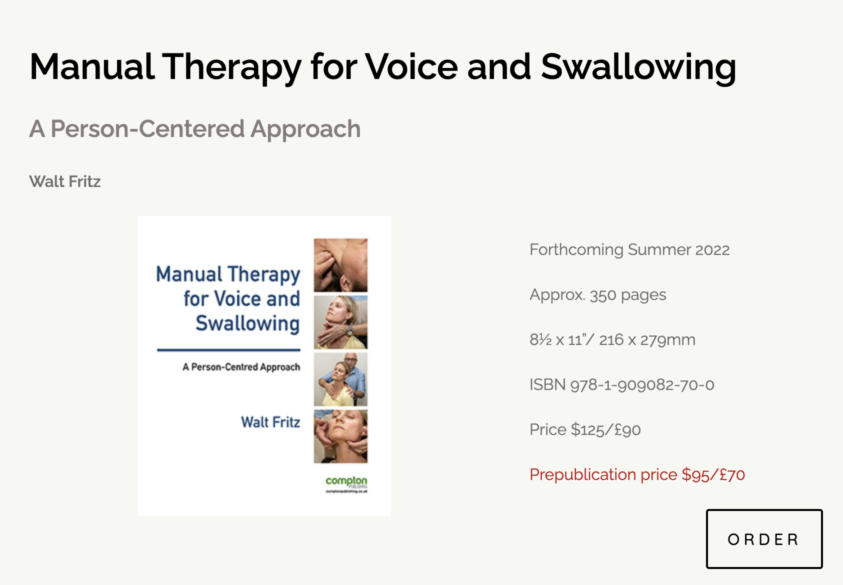
For example I find the palpation that indicates it may be connected to the issue and the client agrees. I ask the client to move. [step forward with one foot] If they ask which one, I say I don’t know. Only their brain knows which movement is the safest. After spending some time evaluating that move and position, whether it is involved in the complaint, makes things better or worse; can we cautiously try the opposite move to see if that leads to more discovery.
Hi Hans, I marvel at the way we come up with ways to engage our patients in meaningful action. I am even more appreciative of models that minimize the concept of nocebo introduction (pathologizing), based on the tissue-based narratives most were taught. Bravo for your approach!